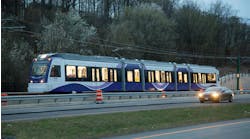MTA rolls out new R211S subway cars on Staten Island Railway
The Metropolitan Transportation Authority (MTA) has rolled out its new R211S subway cars to service on the Staten Island Railway. The cars are part of a 535-car order, which includes 440 R211A standard cars with 75 Staten Island Railway cars and 20 cars with the open gangway feature.
The MTA's R211S cars feature 58-inch-wide door openings that are eight inches wider than standard door openings on existing cars. The new doorways will help to speed up boarding and reduce the amount of time trains sit in stations. MTA notes the new cars are also six times more reliable than cars in the current fleet – able to travel an average of 240,000 miles between replacements and major repairs.
“Staten Island Railway customers will now enjoy a faster, cleaner and safer commute on the new R211Ss,” said New York City Transit Interim President Demetrius Crichlow. “These new cars are state-of-the-art, featuring the latest security and digital communications technology, all to ensure customers have the most comfortable and convenient ride.”
These models include security cameras, additional accessible seating, digital route displays that will provide more detailed station-specific information and brighter lighting and signage, among other features that improve the customer experience.
MTA notes the current class of cars on the Staten Island Railway are R44s, which joined the Staten Island Railway in 1973 after debuting on the subway the previous year.
In October 2022, the MTA Board approved an order of 640 additional standard R211 subway cars, bringing the total number of new subway cars to 1,080 within the next two years.
“These new Staten Island railway cars have been long overdue,” said Staten Island Borough President Vito Fossella. “Staten Island has long been behind the rest of the city in rail transportation and replacing 50-year-old cars with brand new ones is a welcome development. We support further efforts to improve the commuter experience for the Staten Islanders who rely on the train for their day-to-day lives.”



